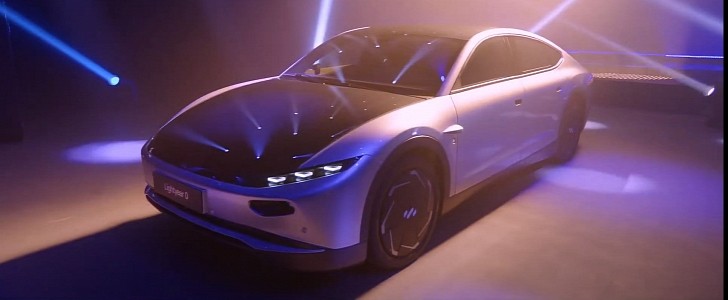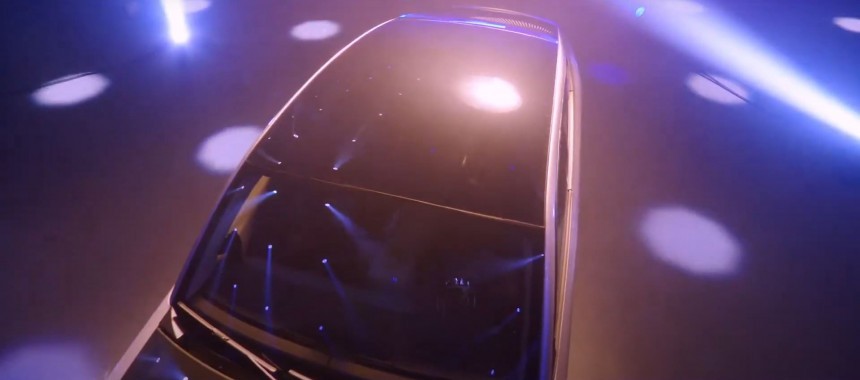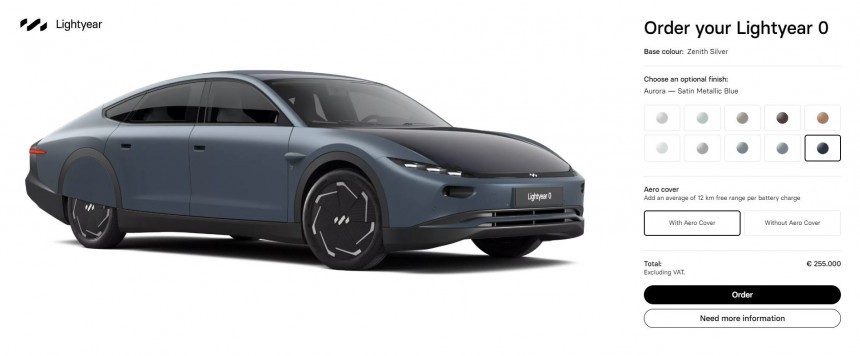The team behind Lightyear started with a dream. They wanted to be pioneers in the field of zero-emission transport. It took them six years. Now the Lightyear 0 is here as the first proper solar car you can order and drive like any other vehicle. Here’s how it works and what you should know about it.
Lightyear’s efforts culminated after six long years with this vehicle. The company wants to offer people, corporations, and governments the right tools to achieve the green targets set for 2040 and 2050. They don’t intend on being another Tesla or Rivian, and that’s why Lightyear 0 is the world’s first production-ready solar car. It’s another idea – one that wants to avoid what all-electric or even hydrogen-powered cars are currently trying to do.
Moreover, the startup’s CEO admits EVs are harder and more complex to use than combustion cars. He blames the small range, the much-needed planning, and the often-needed charging with electricity that doesn’t come from enough renewable sources yet.
“At Lightyear we’re quite obsessed with climate change. It’s a problem that’s been getting bigger and bigger since we were little kids. As engineers, we’ve been looking at how we can contribute. We all know that internal combustion cars are part of the problem and electric cars are a step in the right direction. But electric cars add a lot of complexity to our daily lives, but also the infrastructure. (…) We have to accelerate and be quicker. (…) Now there’s a simpler way,” said Lex Hoefsloot, CEO and Co-founder of Lightyear.
Lightyear has also received funding from the European Union through the Horizon 2020 program.
The CEO said the validation prototype equipped with a 60-kWh battery – Lightyear 1 – has been driven in a normal test cycle for 440 mi (708 km). A rear-wheel-drive Tesla Model 3 with the same unit can reach 180 mi (289 km) of range in normal driving conditions. Keep in mind range is not definitive with any car. A lot of factors matter here, but with EVs, weather can have a real impact. We can expect the same from a solar car.
The prototype Lightyear 1 is now the production-ready Lightyear 0. The vehicle is currently road-legal, and it will soon be seen on the road in the Netherlands and Spain. The solar car is, according to Lightyear, the most energy-efficient model currently available on the market. That’s mostly thanks to its 5 square meters (53.8 sq-ft) of solar cells arranged in double-curved solar arrays on the hood and the roof. On a typical day with no clouds, owners will be able to enjoy almost 44 mi (70 km) of extra range provided by converted electricity from none other than our Sun.
Depending on the country you’re living in, Lightyear says you could drive for up to seven months and 4,598 mi (7,400 km) without having to plug in the car. Granted, that’s available for those living in Portugal, but we can see it happen in Miami or Las Vegas.
Lightyear revealed that commuters will be able to obtain an extra 6,835 mi (11,000 km) of range just from traveling around. This has been concluded after tests done in Southern Spain.
Also, when plugged in at a public station, the car can add 323 miles (520 kilometers) in just one hour. At home, at a regular outlet, you'll be able to get just 20 mi (32 kilometers) of range for every hour it stays connected.
Aerodynamics matter and the shape of the car almost gives it away, but Lightyear claims this is the most aerodynamic efficient family car with a Cd of under 0.19. The well-known Mercedes-Benz EQS comes close with its 0.20 drag coefficient.
Thanks to a body made in its entirety from recycled carbon fiber and no snazzy shapes or side mirrors, Lightyear 0 weighs 3,472 lb (1,575 kg). It is impressive! We were already getting used to EVs weighing more than two tons. This is good progress in terms of keeping the battery packs away from impacting range.
Lightyear 0 measures 200.1 in (5,083 mm) in length, 77.6 in (1,972 mm) in width, and 56.8 in (1,445 mm) in height. The car’s ground clearance is 7.2 in (183 mm). The trunk’s volume is 640 liters.
Surprisingly enough, the top speed is limited to 99 mph (160 kph), and the 0-62 mph (0-100 kph) acceleration time is 10 seconds.
Customer test drives will begin in July and August, and production will start in October this year. The first deliveries will happen in November or December.
The configurator is also live. We’ve built our model, and all you have to do is decide what color you’d like the most and if you want the aerodynamic covers for the rear wheels. We’ve picked the satin metallic blue called “Aurora” and the covers. The price we got was $270.771 (€255,000).
It’s a little steep for your average driver that wants to give up on burning fossil fuels, but we must remember innovation and environmentally friendly manufacturing or parts sourcing don’t come cheap.
The car's brochure is available for download at the end of the article.
The company is also planning on bringing to the market another solar car named Lightyear Two. This one will be priced at $31,850 (€30,000), and LeasePlan has already reserved 5,000 units for their rental fleet!
“What began as a dream set a bright, pioneering reality into motion,” said Lightyear about their production-ready solar car. Now let’s see if it’s going to live up to expectations. Delivering in this economic climate is not going to be easy, especially as inflation is still causing problems and the international geopolitical context does not favor bold, global action. Parts are also not that easy to source.
One thing’s for sure: it’s great to see that innovation continues to happen in the automotive sector, and new car companies are trying their best to replace legacy automakers. We’ll see who succeeds and what our world will end up looking like. The clock’s ticking - for us all!
Moreover, the startup’s CEO admits EVs are harder and more complex to use than combustion cars. He blames the small range, the much-needed planning, and the often-needed charging with electricity that doesn’t come from enough renewable sources yet.
“At Lightyear we’re quite obsessed with climate change. It’s a problem that’s been getting bigger and bigger since we were little kids. As engineers, we’ve been looking at how we can contribute. We all know that internal combustion cars are part of the problem and electric cars are a step in the right direction. But electric cars add a lot of complexity to our daily lives, but also the infrastructure. (…) We have to accelerate and be quicker. (…) Now there’s a simpler way,” said Lex Hoefsloot, CEO and Co-founder of Lightyear.
Progress continues to happen everywhere
With simplicity and environmental goals in mind, Lightyear confirms it now has 500 employees and over 100 suppliers, which helped with the bringing of the Lightyear 0 to the market. The company also wrote 57 patents and redesigned over 1,000 components to make the car exactly as it wanted.Lightyear has also received funding from the European Union through the Horizon 2020 program.
The CEO said the validation prototype equipped with a 60-kWh battery – Lightyear 1 – has been driven in a normal test cycle for 440 mi (708 km). A rear-wheel-drive Tesla Model 3 with the same unit can reach 180 mi (289 km) of range in normal driving conditions. Keep in mind range is not definitive with any car. A lot of factors matter here, but with EVs, weather can have a real impact. We can expect the same from a solar car.
The prototype Lightyear 1 is now the production-ready Lightyear 0. The vehicle is currently road-legal, and it will soon be seen on the road in the Netherlands and Spain. The solar car is, according to Lightyear, the most energy-efficient model currently available on the market. That’s mostly thanks to its 5 square meters (53.8 sq-ft) of solar cells arranged in double-curved solar arrays on the hood and the roof. On a typical day with no clouds, owners will be able to enjoy almost 44 mi (70 km) of extra range provided by converted electricity from none other than our Sun.
Lightyear revealed that commuters will be able to obtain an extra 6,835 mi (11,000 km) of range just from traveling around. This has been concluded after tests done in Southern Spain.
Also, when plugged in at a public station, the car can add 323 miles (520 kilometers) in just one hour. At home, at a regular outlet, you'll be able to get just 20 mi (32 kilometers) of range for every hour it stays connected.
It’s all coming together!
Lightyear 0 has four motors, one for each wheel, and can travel continuously on the highway for 347 mi (560 km) at 68 mph (110 kph) with no sunshine available for the entire trip.Aerodynamics matter and the shape of the car almost gives it away, but Lightyear claims this is the most aerodynamic efficient family car with a Cd of under 0.19. The well-known Mercedes-Benz EQS comes close with its 0.20 drag coefficient.
Thanks to a body made in its entirety from recycled carbon fiber and no snazzy shapes or side mirrors, Lightyear 0 weighs 3,472 lb (1,575 kg). It is impressive! We were already getting used to EVs weighing more than two tons. This is good progress in terms of keeping the battery packs away from impacting range.
Lightyear 0 measures 200.1 in (5,083 mm) in length, 77.6 in (1,972 mm) in width, and 56.8 in (1,445 mm) in height. The car’s ground clearance is 7.2 in (183 mm). The trunk’s volume is 640 liters.
Surprisingly enough, the top speed is limited to 99 mph (160 kph), and the 0-62 mph (0-100 kph) acceleration time is 10 seconds.
Customer test drives will begin in July and August, and production will start in October this year. The first deliveries will happen in November or December.
The configurator is also live. We’ve built our model, and all you have to do is decide what color you’d like the most and if you want the aerodynamic covers for the rear wheels. We’ve picked the satin metallic blue called “Aurora” and the covers. The price we got was $270.771 (€255,000).
The car's brochure is available for download at the end of the article.
The company is also planning on bringing to the market another solar car named Lightyear Two. This one will be priced at $31,850 (€30,000), and LeasePlan has already reserved 5,000 units for their rental fleet!
“What began as a dream set a bright, pioneering reality into motion,” said Lightyear about their production-ready solar car. Now let’s see if it’s going to live up to expectations. Delivering in this economic climate is not going to be easy, especially as inflation is still causing problems and the international geopolitical context does not favor bold, global action. Parts are also not that easy to source.
One thing’s for sure: it’s great to see that innovation continues to happen in the automotive sector, and new car companies are trying their best to replace legacy automakers. We’ll see who succeeds and what our world will end up looking like. The clock’s ticking - for us all!















